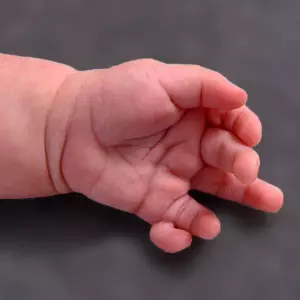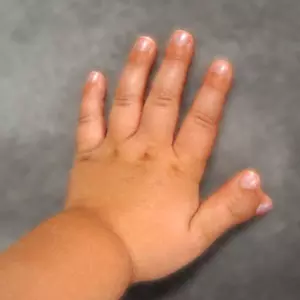- Home
- About Us
- Videos
- Dr. Charles Goldfarb
- Extra Digits (Radial Polydactyly)
Extra Digits (Radial Polydactyly)
Transcript:
Hi, my name is Charles Goldfarb. I'm an orthopedic surgeon at Washington University in St. Louis. I see patients at the Orthopedic Center in Chesterfield, St. Louis Children's Hospital, and the Shriner's Hospital For Children. Kids born with hand and upper extremity abnormalities often come to these sites to see me for evaluation and treatment.

Extra digits occur about 1 out of every 1000 live births. They can be either simple or complex in nature. The more straightforward extra digits typically occur on the small finger side of the hand. Those digits can be very small, remnant-type digits, or they can be fully formed, normal-size digits.
Extra digits on the thumb side of the hand, or what we call radial polydactyly, are more complex by nature. There is a more difficult and rigid surgery required, more of a reconstruction rather than simply a removal of the extra digit.
 Extra digits occur during the normal development of the hand. The hand forms between 26 and 54 days of gestation, and the signaling pathways that normally allow for the development of four fingers and a thumb somehow get out of whack. That leads to either an extra small finger or an extra thumb. Almost all extra digits are on one side or another. Very rarely do you have an extra digit in the middle.
Extra digits occur during the normal development of the hand. The hand forms between 26 and 54 days of gestation, and the signaling pathways that normally allow for the development of four fingers and a thumb somehow get out of whack. That leads to either an extra small finger or an extra thumb. Almost all extra digits are on one side or another. Very rarely do you have an extra digit in the middle.
When we have an extra digit on the small side of the hand, two different types of treatment and can be instituted. Sometimes we can treat a patient in the clinic and we can tie off or remove the extra digit while the child is actually in the office and not in the operating room. That’s a very straightforward intervention. There are some negatives, but it can be very successful.
For more well-formed extra digits, a trip to the operating room is required, even on the small finger. For the thumb, every time there is an extra thumb, we got to the operating room, because it is a much more complex reconstructive process. We have to remove the extra digit. We have to stabilize the remaining digits. And it often requires pinning the finger to stabilize it for a period of time and casting for six week.
The timing of surgical intervention varies depending on the deformity. A child born with a very small extra digit on the pinky side of the hand can be treated at a very young age, even 3 to 6 weeks in the clinic. A more well-formed extra digit on the small finger side is typically treated between 6 and 12 months of age. On the thumb side, we have to wait until the child is a bit older and allow better formation of the digits, and a more straightforward reconstruction therefore follows. In the thumb, we typically wait to between 12 and 18 months of age before reconstruction.
More Info: